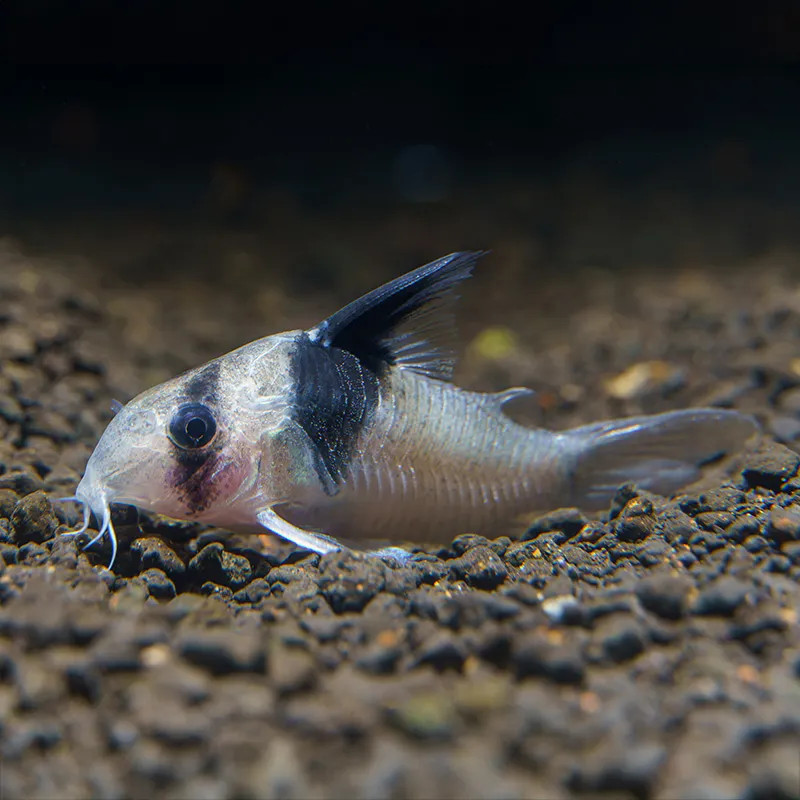Stocks Available
Bronze Cory Catfish
SKU:114184
CORYDORAS AENEUS
1 INCH

Stock Available
Introduction: • Species: Corydoras Panda • Common Names: Panda Corydoras, Panda Catfish • Natural Habitat: Native to the shallow waters of the Amazon River Basin in Peru, where they inhabit sandy substrates and areas with dense vegetation. Physical Characteristics: • Appearance: Notable for their distinct coloration, featuring a white to pale body adorned with black patches on the head and dorsal fin. Their body shape is compact and robust. • Size: Typically grows to about 2.5 inches (6 cm) in length. • Lifespan: Can live for 5-10 years under optimal care. Habitat Requirements: • Tank Size: A minimum of 20 gallons is recommended for a small group, as they thrive in schools. • Water Conditions: o Temperature: Prefers water temperatures between 72-78°F (22-26°C). o pH: Ideal pH ranges from 6.0 to 7.5. • Aquascaping: Use soft substrate, such as sand or fine gravel, and include plenty of hiding spots using plants, driftwood, and caves to provide shelter. Diet: • Primary Diet: Omnivorous; feeds on a variety of foods, including algae, detritus, and small invertebrates in the wild. • Supplemental Feeding: Offer high-quality sinking pellets, freeze-dried or frozen foods (like bloodworms and brine shrimp), and blanched vegetables for a balanced diet. • Feeding Frequency: Feed small portions 1-2 times a day, ensuring they have enough time to forage. Compatibility: • Temperament: Generally peaceful and social; they prefer to be kept in groups of at least 4-6 individuals. • Suitable Tank Mates: Compatible with other small, peaceful fish, including tetras, rasboras, and other Corydoras species. • Incompatibilities: Avoid keeping with aggressive fish or larger species that may view them as prey. Care Level: • Difficulty: Easy to moderate; they are relatively hardy but require stable water conditions to thrive. • Health Monitoring: Regularly check for signs of disease, such as white spots or lethargy, and maintain good water quality to prevent health issues. Breeding: • Breeding in Captivity: Possible with proper conditions; breeding can occur during water changes or when conditions mimic the rainy season. • Spawning: Egg layers; they typically lay their eggs on flat surfaces and will protect them until they hatch. Economic Considerations: • Market Demand: Popular among freshwater aquarium enthusiasts due to their attractive appearance and ease of care. • Wholesale Pricing: Generally affordable, with prices varying based on size and availability. • Retail Pricing: Typically sold at moderate prices, making them accessible for hobbyists. Sustainability and Conservation: • Wild Population: Generally stable, though habitat destruction poses a potential threat in some regions. • Aquaculture Efforts: Frequently bred in captivity for the aquarium trade, which helps reduce pressure on wild populations. Conclusion: Corydoras Panda is a charming and engaging addition to community aquariums. Their sociable nature and attractive appearance make them a favorite among fishkeepers. With proper care and attention to their habitat needs, these catfish can thrive, enriching the aquarium experience for enthusiasts.
Data sheet
16 other products in the same category:
Customers who bought this product also bought: